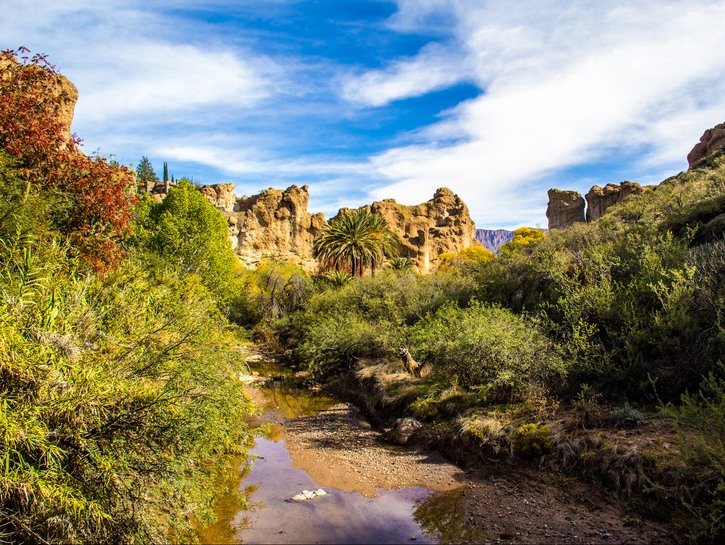
Located 3 miles west of Superior, Arizona, and just over 60 miles from Phoenix, Boyce Thompson Arboretum is Arizona’s oldest and largest botanical garden.
Videos by TravelAwaits
Dedicated to fostering education, recreation, research, and conservation opportunities associated with arid-land plants, the arboretum features flora from the Arizona desert and deserts around the world.
Set alongside unspoiled native Sonoran Desert vegetation with a backdrop of rock formations, Boyce Thompson Arboretum offers both beautiful walks and the chance to learn more about desert vegetation.
And it’s all close enough to make a great day trip from Phoenix.

Donna Janke
History Of Boyce Thompson Arboretum
The Boyce Thompson Arboretum was founded by natural resource developer and philanthropist Colonel William Boyce Thompson.
One of his ventures was Magma Mine in Superior. He built a home, Picket Post, in the Arizona hills, and shortly thereafter purchased over 400 acres of land around the property. He selected Franklin J. Cider of the University of Arizona to establish an arboretum on a portion of that land in the 1920s. Its initial mission was to study the plants of the desert and to make the results available to the public.
The arboretum entered into an agreement with the University of Arizona in the 1960s. It became part of the Arizona State Parks system in 1976. In July of 2019, it became a 501c3 nonprofit.
Boyce Thompson Arboretum Trails
Over 3 miles of nature trails weave through the arboretum. The trails take you past gardens and exhibits that recreate various deserts of the world and offer scenic views of the arboretum and the land around it. When walking the trails, be sure to wear a hat, sunglasses, and sunscreen. Don’t forget to bring plenty of water, and always stay on the path.
Main Loop Trail
The Arboretum Main Trail 1.5 miles long. It begins at the visitor center and is the main trail through the garden. You should allow at least 2 hours to walk the trail and its offshoots.
The trail goes past the Smith Interpretive Center; through the Hummingbird and Butterfly Garden, the Heritage Rose Garden, the Children’s Horticultural Garden, the Taylor Family Desert Legume Garden, and the Cactus and Succulents Garden; and past Ayer Lake before connecting with the Steep Trail. It then takes you past the Wing Memorial Herb Garden, a eucalyptus forest, and a ceremonial stone labyrinth. At the herb garden, be sure to visit the Clevenger House. This stone-and-mortar building was home to a homesteading family of five in the early 1900s. Today, the arboretum uses the house for drying and displaying herbs.
The Steep Trail takes you to the Upland Sonoran Natural Area. Although the trail has a few steep sections and drop-offs, it is not overly strenuous. It offers scenic views of the natural desert mountainside. It also gives you views of the west-facing wall and windows of the 7,000-square-foot Picket Post mansion perched on the volcanic cliffs.
Numerous named and unnamed trails branch off from the Main Loop Trail. The 0.2-mile Magma Ridge Trail takes you through the volcanic cliffs leading to the Cactus and Succulents Garden. The 0.3-mile Chihuahuan Desert Trail features plants from every part of the Chihuahuan Desert. Several connected trails wind through an Australian desert exhibit. These trails include the 0.2-mile Adelaide Track, the 0.1-mile Blue Bush Loop Trail, the 0.1-mile Gum Bark Trail, and the 0.1-mile Walkabout Trail. The 0.2-mile South American Desert Trail showcases plants from the Cuyo, Monte, and Chaco regions of Argentina, Paraguay, and Bolivia.
Only half of the main trail is accessible to those in wheelchairs and to those who use walkers, canes, or crutches. Signs on the trails branching off the Mail Loop Trail indicate accessibility. The Demonstration Garden, the Hummingbird and Butterfly Garden, and the Children’s Horticultural Garden are all wheelchair accessible.
High Trail
The High Trail is a more challenging 0.45-mile path through rugged terrain in the Upland Sonoran Natural Area. It connects with the Main Loop Trail and crosses Queen Creek, offering panoramic views of the area.
Tip: On a hot day, you may want to hike the High Trail and the Steep Trail first thing in the morning, before the heat makes the climb more difficult and less comfortable.
Curandero Trail
The Curandero Trail is a 0.3-mile trail near the visitor center. It exhibits native medicinal and edible plants. In Mexican-American culture, curanderos are traditional healers who use herbal medicines to treat various conditions. Signs provide information about the plants’ natural habitats as well as their uses. The trail is relatively short, but you will want to take your time to read about the various plant remedies and the ways plants can be used as varnishes, dyes, food, skin products, and fuel.

Donna Janke
Boyce Thompson Arboretum Gardens
The arboretum is home to numerous gardens. These areas aren’t specifically sectioned off but rather flow from one to the next as you walk the trail.
The first garden you’ll encounter is the Hummingbird and Butterfly Garden. Although this is a good area to see hummingbirds and butterflies, birds and butterflies are not limited to this section. You will hear birds and spot butterflies throughout the arboretum.
The 300 species of cacti and succulents in the Cactus and Succulents Garden include saguaros, prickly pears, twisted chollas, barrel cacti, and hedgehogs. Cacti produce delicate and intensely colorful flowers that will make a late-spring visit to the arboretum particularly memorable.
The Taylor Family Desert Legume Garden contains mesquite, peanuts, beans, ironwood, and the palo verde, Arizona’s state tree, which is ablaze with yellow flowers in April.
The water-efficient residential theme plots in the Demonstration Garden show ways to live in harmony with the desert by choosing appropriate plant species.
The Wing Memorial Garden contains herbs that have flavored food and healed the sick for centuries. There is also a Heritage Rose Garden.
The Smith Interpretive Center, built of quarried stone, highlights cacti and succulents from around the world.

Boyce Thompson Arboretum Lake And Trees
Ayers Lake, a man-made reservoir, supplies the arboretum with irrigation water. The lake is home to migratory waterfowl and is stocked with two species of endangered fish, the Gila topminnow and the desert pupfish.
As you walk the trails through the arboretum, you can sit, rest, and enjoy the scenery under a grove of palm trees or in the fresh scent of the eucalyptus forest.
Boyce Thompson Arboretum Wildlife
More than 300 species of mammals, birds, reptiles, and amphibians call the arboretum home. You’ll almost certainly see chipmunks and rabbits, but you may also see foxes, coyotes, javelinas, raccoons, coatimundis, bobcats, or even a snake or two. The snakes are important for rodent control. Most are nonvenomous, but you are advised to notify staff if you come across a rattlesnake. A staff member will relocate it.
At least 250 species of birds have been recorded in the arboretum. Lists of the different types of birds on the property are available at the visitor center.

Donna Janke
Events At Boyce Thompson Arboretum
Specialized tours and events offered at Boyce Thompson Arboretum include history tours, geology walks focusing on the rock and volcanic formations along the Main Loop Trail, and guided walks dedicated to specific creatures. On the Edible & Medicinal Plants Tour, you will discover how native plants have fed, healed, and clothed the people of the Sonoran Desert for over 1,000 years. You can take a guided wildflower walk in the spring, and if you’re a shutterbug, you’ll love the photography workshops. Meditation, yoga, and tai chi sessions are offered at times.
Plants are sold at the visitor center all year long; larger selections of plants are available at the arboretum’s fundraising events in October and April.

Donna Janke
Visiting Boyce Thompson Arboretum
The Boyce Thompson Arboretum is open every day except for December 25. Hours vary by season, so be sure to check the website before you visit.
The arboretum’s signage identifies plants and provides lots of information, so you can easily tour the property on your own. To learn more and enhance your visit, consider buying the Main Trail guidebook, which contains information about plants, animals, and natural history that corresponds to numbered signs along the Main Loop Trail. You can also purchase the Curandero Trail guidebook, which describes medicinal and other uses of Sonoran Desert plants.
If you don’t want to tour the arboretum on your own, guided tours are available daily. Whether you visit the arboretum on your own or with a tour, you should allow at least 2 to 3 hours for your visit.
No matter what time of year you visit, you’ll find beautiful scenery and something in bloom. The gardens change with the seasons; you’ll see spring flowers in March and April, cactus blooms in April and May, butterflies and dragonflies in summer, colorful foliage in fall, and plenty of birds in the winter.

Donna Janke
Beyond The Arboretum
There are no restaurants at the arboretum, but there are picnic tables and grills for visitors to use. You can bring your own food or purchase snacks at the gift shop. Alternatively, you can grab a bite to eat in Superior, a small community that was founded as a mining town in 1875.
Be sure to check out the World’s Smallest Museum before heading back to Phoenix. This quirky establishment, located on U.S. Route 60 in Superior, is dedicated to the artifacts of everyday life. Outside the 134-square-foot building, you’ll find sculptures made of rusted tools and mining equipment.
